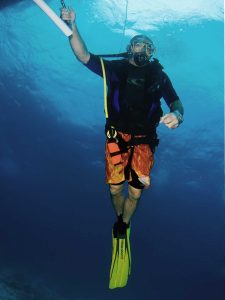DECOMPRESSION ILLNESS | The BENDS
FOR THOUSANDS OF YEARS PEOPLE HAVE WORKED AND EXPLORED UNDERWATER. LIMITED BY BREATH-HOLD CAPABILITIES, DIVERS WERE UNABLE TO STAY SUBMERGED FOR ANY LENGTH OF TIME.
By the mid-1800s, advances in surface-supplied air diving had evolved to allow divers to work for extended periods of time, at depths of 60 to 70 feet. Divers began to report arthritic-like pain and difficulty rewarming. These problems were simply dismissed as symptoms of rheumatism.
About this same time, advances in high-capacity air pump technology led to increased pump output capability and higher pressures. Pressurized chambers were developed to permit large excavation projects below-water, for extended periods of time. This enabled the construction of bridge footings and tunnels underwater, in a dry environment. These chambers were called ‘Caissons’, the French term for big boxes.
The caisson was a major advancement in engineering technology and its use quickly grew. Workers began to complain of new and unexplained maladies upon returning to the surface; breathing difficulties, dizzy spells, and sharp pains in the joints or abdomen. As operating pressures increased and the size of caisson projects grew larger, these complaints increased in number and severity; fatalities occurred with alarming frequency.
The maladies were initially referred to as “Caisson Disease”. Workers on the Brooklyn Bridge project in New York gave this condition the term that has remained—the “Bends”. Initially, the symptoms were attributed to indigestion, arthritis, rheumatism or age. It would soon be learned that these were indications of a far more serious problem.
The French physiologist Paul Bert discovered the cause of caisson disease. Bert determined that breathing air under pressure increased the amount of nitrogen in the blood and tissues of the body. If the pressure were quickly released, as it was when a worker left a caisson, the nitrogen returned to a gaseous state too rapidly for the human body to eliminate the excess amount. Bert realized that the symptoms and fatalities were caused by nitrogen bubbles forming in the body.
When caisson workers began to gradually decompress and divers returned to the surface slowly, the severity of the symptoms decreased. This led to the development of Hyperbaric Chambers which enabled controlled decompression. One of the first operational uses of a chamber was during a tunnel construction project under the Hudson River, between New York and New Jersey in 1879. Hyperbaric chambers began to significantly reduce the health risks of working underwater. Currently referred to as Decompression Illness (DCI), the Bends may be the most well-known hazard of diving.
How and why a diver’s blood and tissues absorb additional nitrogen from the lungs when at depth is now understood. It is also common knowledge that if a diver stays down too long or rapidly ascends, bubbles may form that can contribute to serious complications and even death. Decompression illness is not limited to deep or long dives either. Uncontrolled shallow water ascents and even controlled shallow ascents performed repeatedly, like those experienced during pool training, can cause micro-bubbles to form in the bloodstream, leading to DCI.
Following decompression dive table/dive computer recommendations will reduce the risk of complications attributed to decompression. Dive computers permit an average diver to surface safely under normal conditions. However, a dive computer cannot take into account factors such as dehydration, hypothermia, stress, a diver’s general health or the party last night. There are other factors that can increase the risk of getting ‘Bent’. The vast majority of recreational divers only dive once or twice a year. On vacation, diving is their primary goal, and they want to make the most of it. And, some tend to ‘binge dive’: doing 20 to 25 + dives in a week. | CAUTION | When diving multiple dives in a day: deepest depth first, then dive progressively shallower.
Decompression planning software has come a long way, but there is no magic cure to avoiding DCI. Dive conservatively and listen to your body. If you feel run down or something doesn’t feel right, skip the next dive. Diving is supposed to be fun and enjoyable, not a competition. Enjoy those surface intervals; share your pictures and videos, or just relax with your dive buddies. When you feel up to it, make the next dive and it will be that much more amazing!
 SOME BASIC TIPS TO REDUCE THE CHANCES OF
SOME BASIC TIPS TO REDUCE THE CHANCES OF
DECOMPRESSION ILLNESS WHEN DIVING:
AVOID Alcohol & Caffeine
Stay Well Rested & Hydrated
Maintain Slow Ascent Rates
DO NOT Reduce Minimum Safety Stop Time
AVOID Strenuous Exercise & Over-Exertion
For more advice on DIVING SAFE visit: DAN’S Smart Guide to Safe Diving
